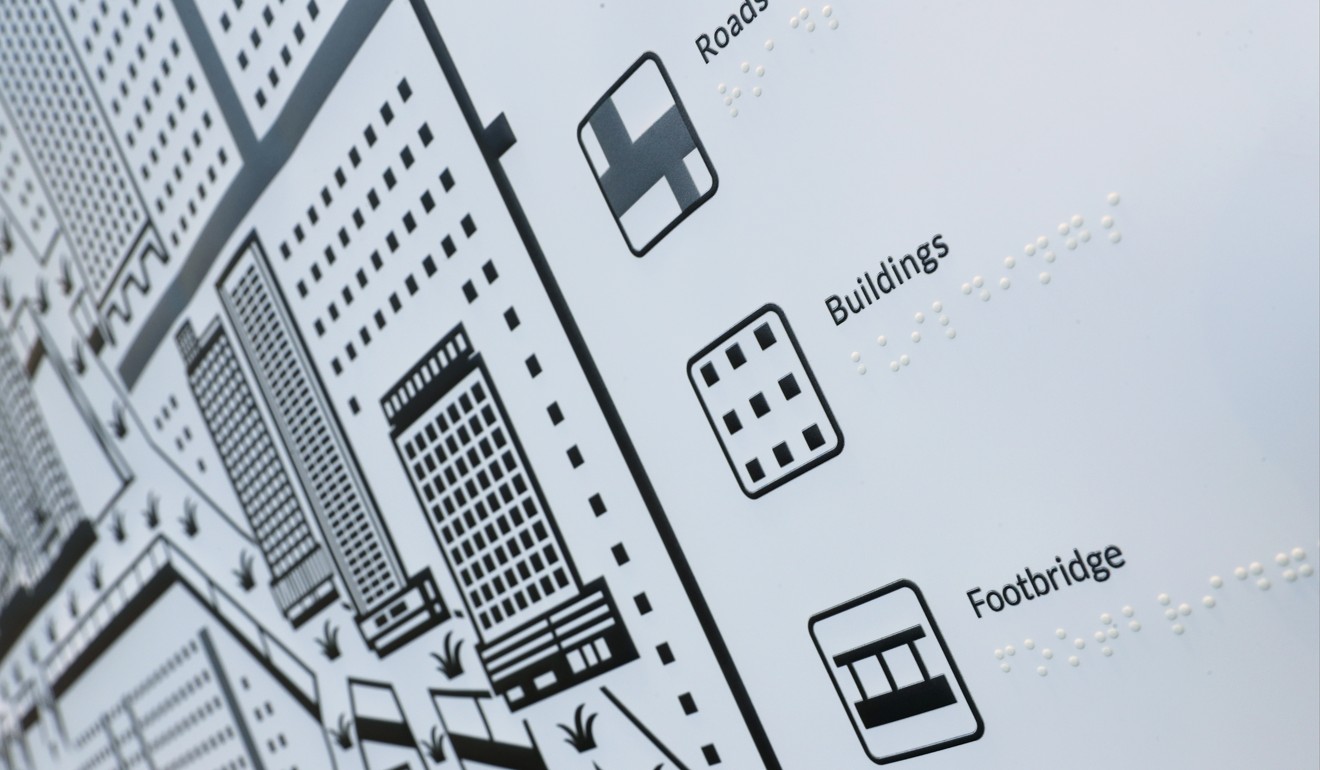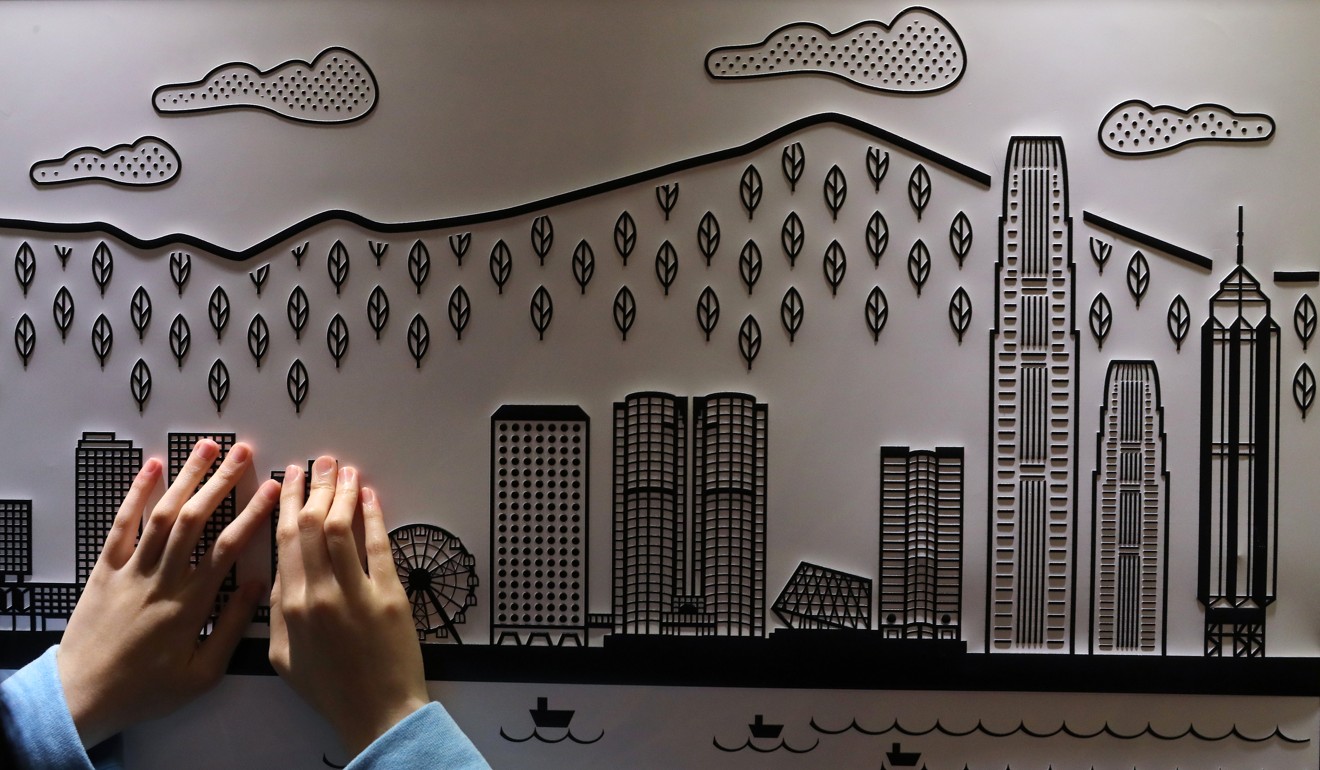
Explore Hong Kong landmarks through paintings you can hear and touch
Central Beyond Vision exhibition aims to reach both sighted and visually impaired visitors with tactile art accompanied by audio descriptions
Dealing with vision loss all her life has shaped many of Joyce Chan Lok-yee’s choices, from mundane ones like how she gets to school to larger decisions like pursuing a language and culture associate degree at Polytechnic University’s Hong Kong Community College.
“I have always been interested in language, that is why I picked it as my major. It was also because it’s easier for me to understand words and phrases, as it’s almost impossible for me to handle calculations and formulas, biology or chemistry, because without sight, it’s hard to understand the teaching materials,” she said.
The 21-year-old takes the bus to her college in Hung Hom because navigating her way through MTR stations “isn’t really an option” for her. “It’s hard to follow the tactile guide paths because there are lots of turns and exits that consist of many rides up and down the escalators, especially when it gets super crowded.”
And while she is interested in words and culture, art exhibitions present a different set of challenges.

“For the visually impaired, we don’t understand images, so when you tell me there’s a line, I don’t know what that is, or when you talk about the different shapes of the clouds, because I have never seen one my entire life. We get words with Braille, spelling out the alphabet one by one,” Chan said.
Central Beyond Vision, an exhibition of tactile paintings, aims to change that by giving both sighted and visually impaired visitors a chance to enjoy depictions of life in the city.
Hong Kong audio describers bring films to life for blind and visually impaired cinema-goers
In addition to the designs being raised, like Braille dots, the artwork, which features some iconic Hong Kong scenes and buildings, comes with audio descriptions of the landmarks.
“When I was feeling the artwork, it was easy to understand and felt as if I was there, at the scene,” Chan said.
Rico Chan, the man behind the project, wanted the exhibition to involve famous places in Hong Kong as they drew crowds of tourists.
“In those popular scenery spots, they often have these huge metal panels containing pictures and descriptions of the place but which are accessible only to sighted people like us, so I thought not much had to be done to change those panels to become handy for the visually impaired,” he said.

The idea for the Tactile-Audio Interaction System, which combines tactile painting with audio description to allow the visually impaired to experience the work through multiple senses, was first proposed six years ago by Chan, the Malaysian founder of social enterprise Beyond Vision Projects.
“I started to realise, a lot of the time, we offer the visually impaired only one piece of information, often neglecting the multisensory information, which is two pieces of information synchronised together. And that is what we are doing – together with the sense of touch, we incorporate audio to allow them to hear what they’re touching.”
The exhibition features 26 pieces and illustrates the pedestrian and transport infrastructure that helps make the city accessible to everyone.

Translating photos into tactile paintings required careful decision-making about how much information to put in.
“We had to precisely craft and decide what elements to include and take out,” Chan said.
The 47-year-old art enthusiast said his team had the toughest time with one specific exhibit, Footbridges Connecting Central District.
“We did a lot of background research and studies on the footbridges. It is something that is so abstract to sighted people, we never look at the bridge from an overview angle, but that is the best view to see and describe it. It took a lot of time just to construct and convert it into graphics and to make a description.

“We did at least four trials, back and forth, to revise the spacing of the buildings and the bridges, as some of them would overlap each other when looked at from a certain perspective, and it wouldn’t make sense.”
Chan hopes that visitors with normal vision will also gain from the event.
“Take the bronze lions at the HSBC main building as an example. I bet you never knew there was a cracked line along one lion’s neck, along with more than 15 bullet holes. We may walk past the statues on a daily basis, but sometimes we take our sight for granted and don’t take the time to admire the things we see.”
Central Beyond Vision will run until April 8 at The Rotunda of the Exchange Square in Central.

